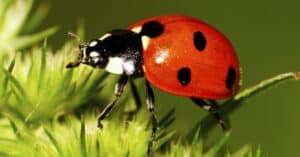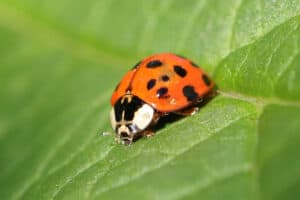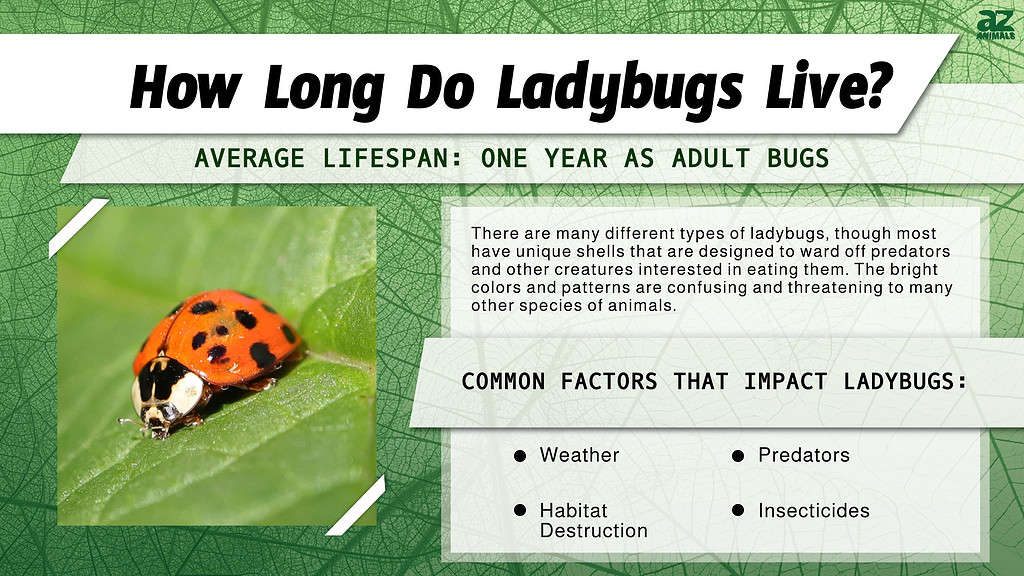
An extremely popular beetle throughout the world, ladybugs are often a sign of luck if you happen to see one in your garden. But how long do ladybugs live, and what exactly is their life cycle like? Many bugs have similar life cycles, but is that also true for ladybugs?
In this article, we will discuss what a ladybug goes through, from egg to adulthood, as well as how their life cycle compares to another popular insect. If you have been waiting to learn more about ladybugs, now is the time! Let’s get started.

A ladybug on a daisy flower. Female ladybugs can eat as many as 75 aphids in one day, they also like to eat scale, mealybugs, and spider mites.
©iStock.com/sebastianosecondi
How Long Do Ladybugs Live?
Ladybugs live roughly one year as adult bugs. They go through a complicated larval and pupa stage which could be considered an additional amount of lifespan time. However, these beginning stages are quick, lasting roughly two months.
A ladybug’s lifespan can be affected by a variety of factors. It can be impacted in the wintertime due to its ability and desire to hibernate. Ladybugs refuse to fly if the temperature is lower than 50 degrees Fahrenheit. If they choose to hibernate, ladybugs can live through the winter off of stored fat and food substances.
Ladybugs are obviously prey to many different species of animals, such as birds and other bugs. However, they have many unique defense mechanisms, such as retreating their head should they sense danger, and excreting an unpleasant smell if threatened. They are also be impacted by a number of issues affecting their environments, such as habitat destruction and insecticides.
The Average Ladybug Life Cycle
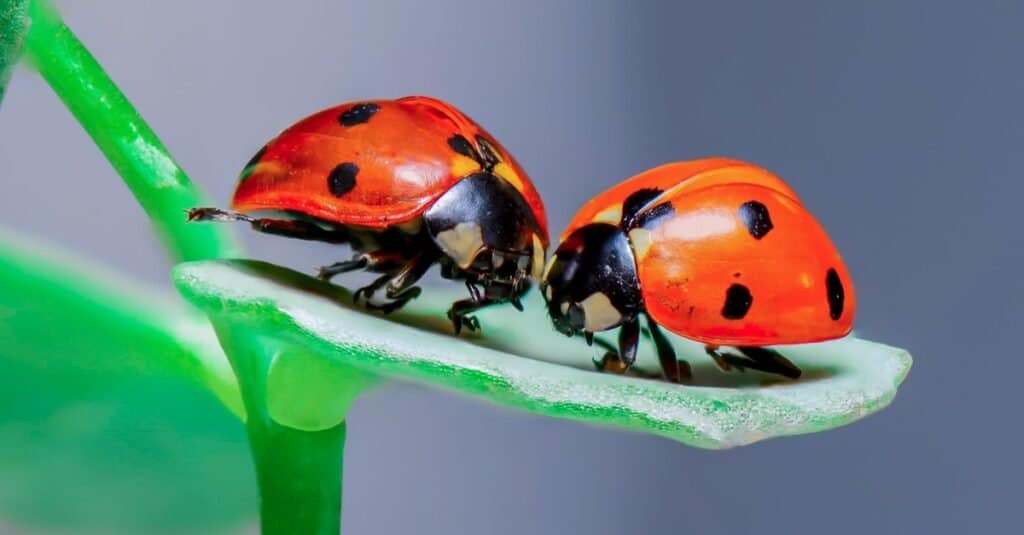
©Pixabay / CC0, Pexels – License
From egg to adulthood, the ladybug lives a very interesting life cycle. If you are here to learn more about what a ladybug goes through during this time, read on!
Eggs and Larvae
A female ladybug can lay over 200 eggs in a single sitting, and it only takes less than a week for them all to hatch. You will recognize ladybug eggs in your own garden if you happen to see a cluster of yellow balls near an aphid colony. This is a mother ladybug’s way of ensuring her children will have food the moment they hatch.
Once the eggs hatch, the larvae will immediately feed on the aphids nearby, given that they can’t travel very far at this young age. However, the larval stage is only the beginning, and it lasts less than a month. From egg to larval stage, a ladybug eats for roughly twenty days before entering its next stage of life.
Pupae
After almost a month, larva ladybugs enter their pupa stage. This is similar to a butterfly‘s cocoon, and the ladybugs will undergo extreme transformations in their pupa shell. Ladybug larvae don’t look anything like their adult counterparts, black and spiny. The pupa stage is when they develop into the bugs we know and love.
Ladybug pupas are yellow with their trademark ladybug black spots, and you may find these resting on a variety of plant matter and leaves. Ladybugs try to pupate in a relatively protected and safe environment. The entire pupating process takes 2 weeks or less.

A ladybug’s lifespan can be affected in the wintertime due to its ability and desire to hibernate.
©Milton Buzon/Shutterstock.com
Adult Ladybugs
An adult ladybug emerges from their pupas after this two-week period of time as a fully grown ladybug. They have their red shells and black spots at this point in time, and they use this unique shell to ward away predators. Why might this be?
There are many different types of ladybugs, though most have unique shells that are designed to ward off predators and other creatures interested in eating them. The bright colors and patterns are confusing and threatening to many other species of animals. You can tell an adult ladybug from a larva ladybug easily, given their very different coloring and patterns.
Adult ladybugs can live up to a year, and this includes the time they spend hibernating in the winter months. Ladybugs can mate soon after emerging from their pupa case, and they immediately seek out aphids. This is their main source of food.
How Does Their Lifespan Compare to Ants?
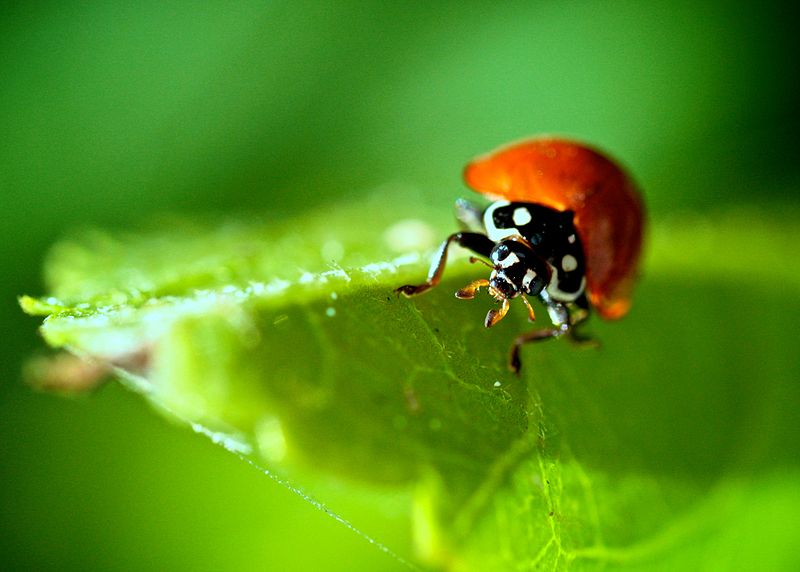
A female ladybug can lay over 200 eggs in a single sitting, and it only takes less than a week for them all to hatch.
While a ladybug’s life span seems short, living a whole year for a bug is pretty impressive. However, there is another common bug that can live even longer than a ladybug. The common garden ant is capable of living longer than a year believe it or not.
While it will depend on the individual ant and their circumstances, ants can live 2 to 4 years in the wild. And this is only true for worker ants. Queen ants have a much different lifespan, and some colonies have queens that are decades old.
Ladybugs do not operate the same way ants do. They don’t have a hierarchy in place for their bug population, and all ladybugs are essentially treated equally. However, no matter the ladybugs, their life span is likely to not last longer than one year.
Ants on the other hand have the protection of their colony as well as a mission to protect their queen. A queen ant is responsible for continuing the colony and ant species in general. But why have scientists claimed that ants can live much longer than ladybugs?
This is likely true due to the fact that ants have a protected home to return to at the end of the day. They forage and bring food back for their fellow workers and queen, while ladybugs often feed while exposed on leaves and branches.
Regardless of how long they live, both ants and ladybugs are important parts of our ecosystem. If you have a home garden or simply an appreciation of bug life, take the time to preserve both of these insects so that your plants can thrive.
The photo featured at the top of this post is © iStock.com/sebastianosecondi
Thank you for reading! Have some feedback for us? Contact the AZ Animals editorial team.



